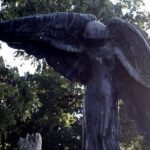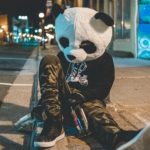 Weird Stuff
Weird Stuff  Weird Stuff
Weird Stuff  Our World
Our World 10 Ways Your Christmas Tree Is More Lit Than You Think
 Movies and TV
Movies and TV The 10 Coolest Stars to Set Sail on The Love Boat
 History
History 10 Things You Didn’t Know About the American National Anthem
 Technology
Technology Top 10 Everyday Tech Buzzwords That Hide a Darker Past
 Humans
Humans 10 Everyday Human Behaviors That Are Actually Survival Instincts
 Animals
Animals 10 Animals That Humiliated and Harmed Historical Leaders
 History
History 10 Most Influential Protests in Modern History
 Creepy
Creepy 10 More Representations of Death from Myth, Legend, and Folktale
 Technology
Technology 10 Scientific Breakthroughs of 2025 That’ll Change Everything
 Weird Stuff
Weird Stuff Ten Bizarre Facts About The Doge Meme
 Our World
Our World 10 Ways Your Christmas Tree Is More Lit Than You Think
 Movies and TV
Movies and TV The 10 Coolest Stars to Set Sail on The Love Boat
Who's Behind Listverse?

Jamie Frater
Head Editor
Jamie founded Listverse due to an insatiable desire to share fascinating, obscure, and bizarre facts. He has been a guest speaker on numerous national radio and television stations and is a five time published author.
More About Us History
History 10 Things You Didn’t Know About the American National Anthem
 Technology
Technology Top 10 Everyday Tech Buzzwords That Hide a Darker Past
 Humans
Humans 10 Everyday Human Behaviors That Are Actually Survival Instincts
 Animals
Animals 10 Animals That Humiliated and Harmed Historical Leaders
 History
History 10 Most Influential Protests in Modern History
 Creepy
Creepy 10 More Representations of Death from Myth, Legend, and Folktale
 Technology
Technology 10 Scientific Breakthroughs of 2025 That’ll Change Everything
Ten Times Towns Were Wiped Off the Face of the Earth
It takes a lot to destroy a town. It’s hard to even imagine how a town could be destroyed. One minute, it’s here, and the next minute, large areas of it—or, in the worst cases, pretty much all of it—are wiped out. Tornadoes, hurricanes, earthquakes, and other natural disasters are, of course, the most likely cause. And while weather warnings have improved exponentially over the years, weather phenomena are still ultimately unpredictable and erratic. Even those who are the best prepared don’t always make it out when the most harrowing times hit.
In this list, we’ll take a look at ten real-life towns that were wiped out by major weather issues and other phenomena. Rebuilding was difficult, resilience was tested, and far too many people lost their lives. Sadly, “here today, gone tomorrow” takes on a whole new meaning for these towns and the unfortunate souls who lived within them.
Related: 10 People Who Survived Multiple Disasters and Deadly Situations
10 Galveston, Texas
On September 8, 1900, a massive category 4 hurricane almost completely leveled the city of Galveston, Texas. On the low end, historians today estimate that 6,000 to 8,000 people died. Less conservative estimates hold that upward of 12,000 people were killed by the horrific storm. And many, many more were gravely injured.
Even more Galveston residents completely lost their homes and businesses. More than 3,000 homes were completely destroyed and unsalvageable. Thousands more were seriously damaged. Total property losses in Galveston were estimated at the time to be $28 to $30 million—or the equivalent of well over $1 billion today.
Still today, the Galveston Hurricane of 1900 remains the deadliest natural disaster in United States history. Most of the deaths were caused by saltwater drowning as a 16-foot-tall (4.9-meter) storm surge swept across the coastal areas of the city. Destructive waves pounded buildings and hammered into people. Others were trapped inside buildings as rising seawater left them nowhere to go.
Unfortunately, with weather tracking at the time being completely primitive, nobody had any indication that the storm was coming that ferociously. The intensity completely rocked the city of Galveston, and the entire area had to be cleaned out and rebuilt in the years after the storm receded.[1]
9 Greensburg, Kansas
On the evening of May 4, 2007, the small southern Kansas town of Greensburg was completely decimated by an EF5 tornado. The tornado had been under a warning for the area, but nobody knew it would be that big, that powerful, or so strong as to take out an entire town. And while Greensburg is a small town by any standard—just 1,400 people lived in it when the tornado hit—the sheer scale of the destruction was mind-boggling.
Every single building except for one in Greensburg’s downtown was completely and entirely leveled. In fact, more than 95% of the town was leveled and decimated. Only a few dozen buildings on various ends of the town were spared from the wrath of the massive twister, which was more than a mile wide as it roared through the farming village.
Amazingly, only eleven people in Greensburg were killed by the devastating tornado. Two more people were killed in another, even smaller town outside of it. Dozens more were injured, some seriously, although police and paramedics were able to transport the injured to hospitals in the region surprisingly quickly. Thankfully, modern weather-watching technology at least warned people of the impending disaster—even though nobody knew just how bad it would be.
Miraculously, Greensburg rebuilt itself over the next decade. It even became a “green” town, with many of its buildings certified as environmentally conscious and cutting-edge. The population hasn’t quite recovered to pre-tornado levels, though, and it probably never will.[2]
8 Hinckley, Minnesota
On the night of September 1, 1894, a massive fire swept through the small town of Hinckley, Minnesota. It killed at least 418 residents—although historians now believe that many more people actually died—and thousands more pets and heads of livestock perished in the horrific blaze. It all started back in 1891 when central Minnesota settled into an unusually long drought.
For the next three years, drought conditions prevailed, and soil moisture was steadily lost. In the summer of 1894, far less than two inches of rain fell, which was a shockingly low total for that area of the country at that time. Fires had been burning all summer, but none were truly massive. None until the night of September 1, which was a Saturday.
That evening, a thermal inversion was present in the area. That is a weather phenomenon where hot air near the ground is trapped by a layer of cold air above it. The hot air can’t escape, and even with winds whipping up, the dry conditions caused by the hot air make a space into a veritable tinderbox with only a small spark needed to catch.
Sadly, that’s exactly what happened. At the Brennan Lumber Company in Hinckley, a spark was lit from within the huge sawdust piles at the site. Soon, embers were flying in the wind and catching onto other very dry, very risky things around town. In what seemed like an instant, buildings and trees alike were going up in flames and blazing with intensity.
The people had few places to go and very little time to get out. Embers were blowing so far and so fast in the wind that the town and its surroundings were all caught very quickly within the perimeter of the flames. The fire built up a solid, impenetrable wall along the south, east, and west sides of town and quickly moved north.
People hid in underground wells and then died from smoke inhalation when they were unable to breathe as the fire moved above them. Other people literally jumped into lakes and waited for hours and hours overnight in waist-deep water, desperately trying to brush off embers that landed on their bodies.
In the end, the official death toll was 418 people—and the entire town of Hinckley was destroyed. Locals at the time and historians today agree, though, that far more people were likely killed than that. Chillingly, bodies were still being discovered for years after the fire was extinguished. The final discovered body confirmed to be a Hinckley fire death was found in May of 1898—nearly four years after the fire. The town and its inhabitants were completely destroyed.[3]
7 Johnstown, Pennsylvania
On Friday, May 31, 1889, the town of Johnstown, Pennsylvania, was completely destroyed by a flood. In what came to be known as the Great Flood of 1889, the South Fork Dam of the Little Conemaugh River gave way, and water surged through onto the town below.
There had been very heavy rains in the days leading up to the tragedy, and so the river was far more full than it usually was. The dam simply wasn’t up to the task of protecting the city of Johnstown, and in turn, 2,209 people lost their lives while their town was almost entirely destroyed.
In total, the dam released about 14.55 million cubic meters of water. The rush of the flow was so powerful that the currents were moving faster than the average flow rate of the widest and strongest parts of the mighty Mississippi River. From a financial perspective, the flood caused about $17 million worth of damage at the time—the equivalent of well over a half billion dollars today.
Of course, the 2,200+ people killed were the real story. The American Red Cross rushed into the town, with Clara Barton and 50 other volunteers undertaking one of the first large-scale disaster relief efforts ever seen in the United States. It wasn’t enough to save those who drowned or were swept downstream and never heard from again, though, or to rescue their destroyed town.
Now, the Johnstown “Great Flood” remains one of the most terrible and heartbreaking tragedies in the entirety of American history.[4]
6 Dujiangyan, China
On May 12, 2008, China’s Sichuan Province suffered the effects of one of the deadliest earthquakes of all time. The so-called Sichuan Earthquake was measured by Western seismologists as a 7.9 magnitude event and by Chinese seismologists as an 8.0 magnitude quake. It shook the entire Sichuan Province, about 1,000 miles (1,609 kilometers) southwest of Beijing.
It was felt for hundreds and hundreds of miles all around. Most notably, though, the earthquake centered on the city of Dujiangyan. Almost unimaginably, nearly 90,000 people were killed. Another 19,000 were reported missing, and more than 375,000 people suffered various injuries, from minor to severe.
Dujiangyan saw unprecedented city damage as well. More than four million people were displaced all across the province. And stunningly, millions of buildings and structures either collapsed entirely or were so severely damaged that they had to be razed and rebuilt. In total, the reconstruction costs alone came in at an estimated $150 billion—not including the financial losses suffered by businesses and families in the quake itself.[5]
5 Moore, Oklahoma
In the early afternoon of May 20, 2013, a huge and historically intense EF5 tornado destroyed the city of Moore, Oklahoma, and some of its surrounding areas. Peak winds of the near-historic tornado were up to 210 miles an hour. The tornado was the biggest part of a larger weather system that tore across the Great Plains and the Midwest over the previous 24 hours.
Other tornadoes and violent thunderstorms were reported elsewhere in Oklahoma, Kansas, Nebraska, and North Texas on May 19. So people in the area were somewhat ready for a big storm to come through on May 20. And that part of it was fortunate since the devastating tornado in Moore only killed 24 people. Had weather tracking systems not been as advanced, it undoubtedly would have killed many, many more. Another 212 people were injured.
In addition to the casualties, the real story of the storm was what it did to Moore. The tornado was more than a mile wide in diameter, and amazingly, it stayed on the ground for more than 39 minutes. Over nearly 14 straight miles of destruction, it went right through the heart of the town of Moore. Hundreds of homes, schools, commercial buildings, and other structures were completely decimated.
That it lasted so long on the ground was no doubt a major blow, too. Paramedics and first responders couldn’t get to people in need quickly as the storm sat right on top of Moore as if it had been purposely planted there. As of early 2024, the Moore tornado remains the most recent EF5-rated storm anywhere in the world.[6]
4 San Francisco, California
Very early in the morning on Wednesday, April 18, 1906, one of the most powerful earthquakes ever recorded at the time struck off the Pacific Ocean in northern California, not far from San Francisco. The quake, which registered at 7.9 on seismographs indicating that it was unusually extreme, rocked the entire town.
High-intensity shaking was felt far into northern California toward Oregon, too, and as far south as farm towns deep into the rural Salinas Valley. But the biggest and most violent shaking came in San Francisco. The shake caused many buildings to crumble and collapse on their own. But in addition, and what proved to be far more devastating, was that it caused all kinds of leaks and ruptures and splintering of pipes and gas lines. Those ruptures caused devastating fires to break out all across San Francisco.
For the next several days, the fires spread. Most roads in town weren’t paved at the time, and the combination of the quake and the awful road conditions meant horses couldn’t get down streets to rescue people or bring first responders. In addition, the fire hoses that were able to put out small sections of the fires also muddied the streets so much that people had difficulty evacuating. The fires spread rapidly along the town’s packed-in streets, leading to complete devastation.
By the end of a week of horrific fires following the earthquake, more than 80% of San Francisco was completely destroyed and unsalvageable. It was a miracle that the death toll was only above 3,000 and not significantly higher. Still, it was a truly life-shattering quake and aftermath.
Even today, the 1906 San Francisco Earthquake remains the deadliest earthquake in the history of the United States. The aftermath, including days of fire, led to the greatest loss of life from a natural disaster in the history of the state of California. As for San Francisco, it had to be nearly entirely rebuilt in the years after the awful incident.[7]
3 Joplin, Missouri
Life changed forever for the residents of Joplin, Missouri, on the evening of Sunday, May 22, 2011. As part of a much larger tornado outbreak across the Midwest, an EF5 tornado developed just west of Joplin and intensified very quickly. It was nearly a full mile wide when it ran right through the southern part of the city. Well over 8,000 buildings were horribly damaged during the tornado’s run through town, with more than 4,000 buildings being completely destroyed beyond repair.
Power lines were downed for miles, city structures and public spaces were ruined, and the entire southern section of the town was decimated in a flash. Worst yet were the deaths: 161 people died in the tornado, with eight more indirect deaths on top of that. Another 1,150 had serious injuries to boot.
To this day, the Joplin tornado ranks as both one of the most powerful and deadliest tornadoes in American history. Sadly for Joplin, it wasn’t even the first time they took a direct tornado strike. Since May 1971, the southern Missouri city has seen three direct tornado hits with serious damage.
The 2011 EF5 tornado was by far the worst, though. It destroyed nearly half of the city, took out of commission one of the town’s two hospitals, and caused insurance companies to pay out more than $2.8 billion in claims and settlements in the aftermath. Joplin has since been mostly rebuilt, but the memory of the tornado and its tragic aftereffects lives on in the minds of locals and likely always will.[8]
2 Port-au-Prince, Haiti
A massive 7.0 magnitude earthquake struck just west of the capital of Haiti, the beleaguered city of Port-au-Prince, on January 12, 2010. The epicenter was about 16 miles (25.7 kilometers) west of town, and its proximity to the large city proved devastating. There are, of course, earthquakes bigger than 7.0 in magnitude—including ones we’ve learned about already on this list.
However, the Haitian earthquake was one of the most devastating in the history of the world simply because the city of Port-au-Prince was so ill-equipped to deal with it. In total, more than three million people were affected dramatically by the quake and its four dozen aftershocks of 4.5 magnitude or greater that came over the next ten days.
The lowest estimates of the death toll claim it was at least 100,000 and possibly as many as 160,000. The highest estimates from the Haitian government itself assert that anywhere from 220,000 to 316,000 people died—an inconceivable amount for such a relatively small capital city of a small island nation. And because Haiti is such a poor nation, the death toll increased greatly during the disaster due to bad building construction practices, inadequate city infrastructure, and related issues.
Port-au-Prince and the nearby city of Jacmel were mostly flattened in the quake. Thousands and thousands of buildings were destroyed beyond repair. Many notable buildings were part of the destruction, including the National Assembly Hall, the Port-au-Prince Cathedral, the Presidential Palace, the city’s main jail, and the headquarters of the United Nations Stabilization Mission in Haiti.
It took years to recover from the city’s destruction—and many parts of it simply never recovered at all.[9]
1 Bogale, Myanmar
On Friday, May 2, 2008, the southeastern Asian nation of Myanmar suffered the worst natural disaster in its history. That’s when Extremely Severe Cyclonic Storm Nargis made landfall near the city of Bogale and several other municipalities in the tropical nation. The area around Bogale is known as the Irrawaddy Delta, a very low-lying land mass off the Indian Ocean that is highly populated.
Nargis was such an intense and violent cyclone that it sent a storm surge 25 miles (40.2 kilometers) into the delta and far beyond the coast. The surge going that far inland and lasting for so many days was completely unexpected by the people of Labutta Township and other areas around Bogale. According to official estimates, more than 80,000 people died across the Irrawaddy Delta. Just in Bogale alone, there were over 10,000 deaths in addition to the city being flattened.
As officials descended on Bogale, they found even more deaths throughout the area. In the end, they classified another 55,000 people as missing and unaccounted for after the storm finally dissipated days later. Those numbers may be on the low side, though. Critics of Myanmar’s government claimed at the time that officials purposely stopped updating the death toll after cresting 130,000 to minimize political consequences from the lack of cleanup and rescue.
Regardless, Bogale was completely destroyed by the cyclone, and its residents who managed to survive had to flee inland for medical help, food, and resettlement. The rest of Labutta Township was mostly washed away, as well. Damage estimates came in at more than $12 billion worth of destruction—an unprecedented number for the people of Myanmar.
At the time, it was the costliest tropical cyclone on record in the history of the Indian Ocean, too. All around, Nargis proved to be devastating. But the worst part, by far, was Bogale’s destruction and the loss of so many lives during those perilous first few days.[10]








